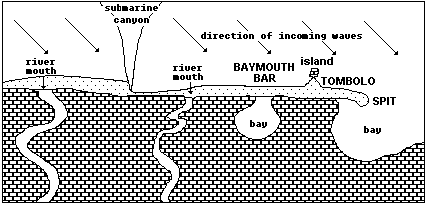1. In the trough of a wave, water moves towards the approaching crest. Water will move up as the crest nears and forward at the exact moment the crest arrives. As the crest passes, the water falls. Put all that motion together, and the path that a water particle traces out as each wave disturbs it is a circular orbit.
2. As waves move into shallow water they slow down, bunch-up (wavelength decreases), and become higher and steeper.
3. Summer waves generally come from more distant storms than do winter waves. Such waves tend to be lower, less steep (decreased H/L) and less frequent. Because of their small height and relatively long length, the distance between where such waves touch bottom and break is great. In this zone net sand transport is toward the beach (provided the bottom has been flattened significantly by the large, steep and frequent waves of the previous winter). Because of the lower wave heights, the "summer" surf zone will be narrow and longshore transport insignificant. Sand suspended by waves breaking in the surf zone swashes up the beach face, but less will backwash down because wave infrequency generally allows the wave-fed groundwater level to lower such that most of the swash infiltrates. Such action tends to deposit suspended sand grains on the beach face and the beach widens and steepens.
4. a. The longshore current and longshore transport is located in the surf zone, and will move from right to left in the diagram.
b. _2_jetty _3_breakwater _1_groin
c. _4,6,8_erosion _5,7,9_deposition
d. Erosion will happen at location 10 if the dam is built.
e. Because 11 is up drift from the dam, no change should occur there if the dam is built.
5.

6. Wave-cut platforms become marine terraces when the land is uplifted and/or sea level lowers.
7. Wave refraction causes waves to focus their energy on headlands and lose their energy going into bays. Thus, the headlands tend to erode and the products of that erosion will be deposited in the bay. In time, the coast will straighten, As the point erodes, first sea arches form in it as wave erosion carves sea caves into it’s sides near sea level where wave action is greatest. When the arches collapse, isolated portions of the old point remain. These are sea stacks.
8. Emergent coasts expose the products of wave erosion, so marine terraces, sea cliffs, sea caves, sea caves and sea stacks are common.
9. Submergent coasts are characterized by drowned features. Fjords are drowned glacial canyons. Estuaries are commonly drowned river canyons.

8800 Grossmont College Drive
El Cajon, California 92020
619-644-7000
Accessibility
Social Media Accounts